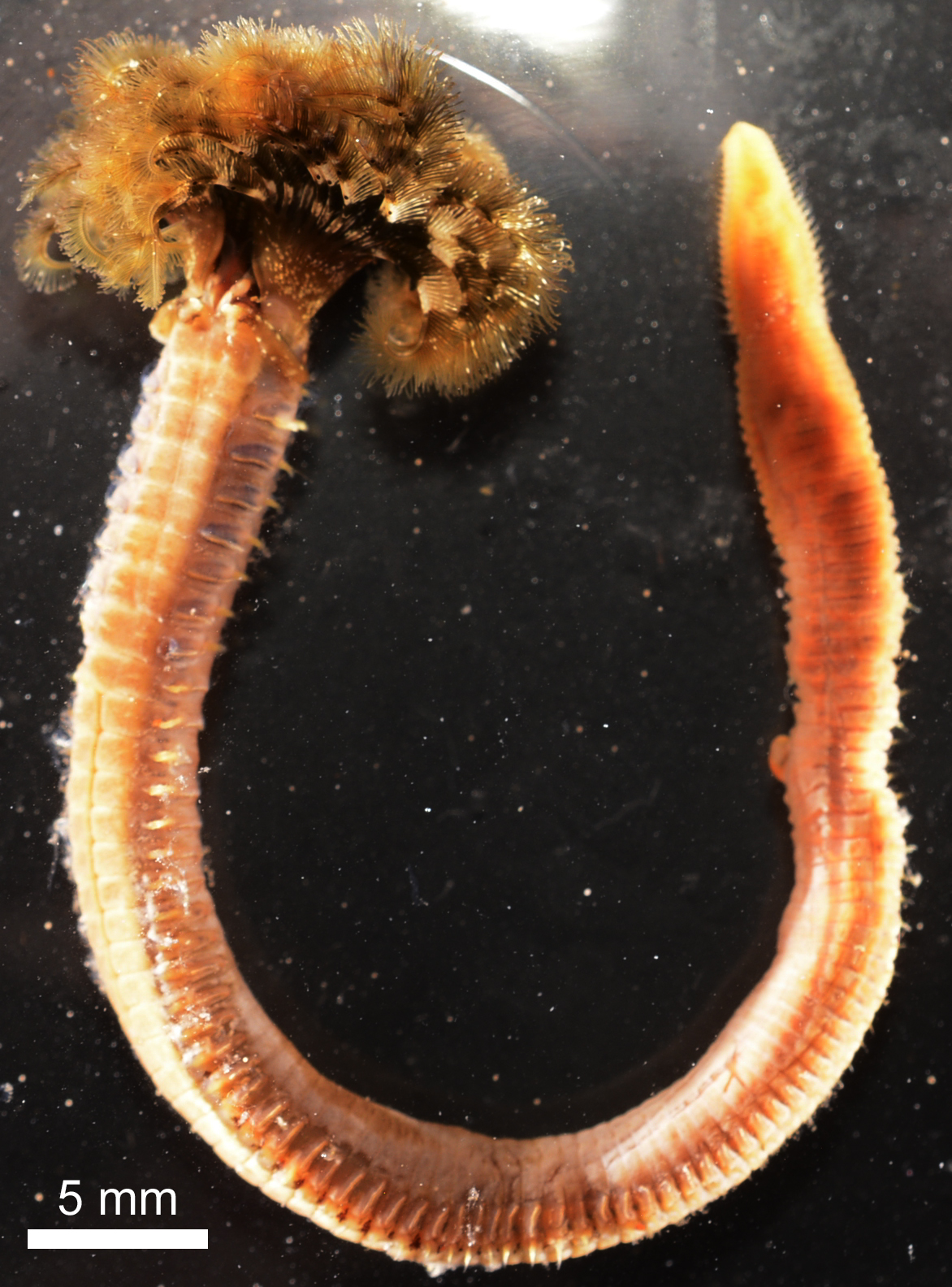A sedentarian polychaete specimen was collected intertidally under stone in Oshoro Bay, Hokkaido, Japan, about 43°12′N, 140°51′E, on 27 Aprril 2015 by Kazuki Tanaka, photographed and fixed in 99% EtOH by Shinri Tomioka; the specimen was identified by Hiroshi Kajihara as Pseudopotamilla occelata Moore, 1905. DNA was extracted from tail assembly using the silica method (Boom et al. 1990) with some modifications. Extracted DNA was dissolved in 30 µl of deionized water and has been preserved at –20°C. Remaining morphological voucher specimen has been deposited at the Hokkaido University Museum under the catalogue number ICHU2130197 (contact: Dr. Hiroshi Kajihara, kazi@mail.sci.hokudai.ac.jp).
PCR amplification was attempted with the primer pairs LoboF1 (5′-KBTCHACAAAYCAYAARGAYATHGG-3′) and LoboR1 (5′-TGTTTYTTYGGWCAYCCWGARGTTTA-3′) (Lobo et al. 2013) for the mitochondrial cytochrome c oxidase subunit I gene (COI) and 16S ar-L (5′-CGCCTGTTTATCAAAAACAT-3′) and br-H (5′-CCGGTCTGAACTCAGATCACGT-3′) (Palumbi et al. 1991) for the 16S rRNA gene. PCR products were visualized by electrophoresis in 1% agarose gel. Of the two gene markers that were attempted, only 16S rRNA gene was confirmed to be successfully amplified. The PCR was performed by a thermal cycler, 2720 Thermal Cycler (Applied Biosystems), in a 20-µl reaction volume containing 1 µl of template total DNA (approximately 10–100 ng) and 19 µl of premix made with 632-µl deionized water, 80-µl Ex Taq Buffer (TaKara Bio), 64-µl dNTP (each 25 mM), 8-µl each primer (each 10 µM), and 0.1-µl TaKara Ex Taq (5 U/µl,TaKara Bio). Thermal cycling condition comprised an initial denaturation at 95°C for 30 sec; 30 cycles of denaturation at 95°C for 30 sec, annealing at 45°C for 30 sec, and elongation at 72°C for 45°C and a final elongation at 72°C for 7 min.
The PCR products of the 16S rRNA gene were purified with the silica method (Boom et al. 1990). Both strands were sequenced with a BigDye® Terminator v3.1 Cycle Sequencing Kit (Applied Biosystems) following the manufacturer's protocol, using the same primer set as the initial PCR amplification. Sequencing was performed with ABI Prism 3730 DNA Analyzer (Applied Biosystems). Chromatogram and sequence data were operated with MEGA v5.2 software (Tamura et al. 2011).
Results and Taxonomy
Phylum Annelida
Order Sabellida
Family SabellidaeLatreille, 1825
Genus PseudopotamillaBush, 1905
Pseudopotamilla occelata Moore, 1905
[Japanese name: erako]
(Fig. 1)
A total of 462 bp of the mitochondrial 16S rRNA gene sequence was determined from ICHU2130297, identified as Pseudopotamilla occelata Moore, 1905 (see Appendix). A nucleotide BLAST search (Altschul et al. 1997) at the NCBI website (https://blast.ncbi.nlm.nih.gov/) resulted in that our sequence from Oshoro showed 83% similarity with HM800980 (E value = 6e–121; 100% in query coverage), a sequence from an unidentified sabellid in the genus Pseudopotamilla (Capa et al 2011). There was no 16S rRNA gene sequence of Pseudopotamilla ocellata deposited in GenBank as of writing.

Fig. 1. Pseudopotamilla occelata Moore, 1905 (ICHU2130197) from Oshoro, Hokkaido, Japan, photographed by Shinri Tomioka.
References
Altschul, S. F., Madden, T. L., Schäffer, A. A., Zhang, J., Zhang, Z., Miller, W., and Lipman, D. J. 1997. Gapped BLAST and PSI-BLAST: a new generation of protein database search programs. Nucleic Acids Research 25: 3389–3402.
Boom, R., Sol, C. J., Salimans, M. M., Jansen, C. L., Wertheim-van Dillen, P. M., and Van der Noordaa, J. 1990. Rapid and simple method for purification of nucleic acids. Journal of Clinical Microbiology 28: 495–503.
Capa, M., Hutchings, P., Teresa Aguado, M., and Bott, N. J. 2011. Phylogeny of Sabellidae (Annelida) and relationships with other taxa inferred from morphology and multiple genes. Cladistics 27: 449–469.
Lobo, J., Costa, P. M., Teixeira, M. A. L., Ferreira, M. S. G., Costa, M. H, and Costa, F. O. 2013. Enhanced primers for amplification of DNA barcodes from a broad range of marine metazoans. BMC Ecology 13:34. DOI: 10.1186/1472-6785-13-34.
Palumbi, S., Martin, A., Romano, S., McMillan, W. O., Stice, L., Grabowski, G. 1991. The Simple Fools Guide to PCR, Ver. 2. Department of Zoology and Kewalo Marine Laboratory, University of Hawaii, Honolulu, 45 pp.
Tamura, K., Peterson, D., Peterson, N., Stecher, G., Nei, M., and Kumar, S. 2011. MEGA5: molecullar evolutionary genetics analysis using maximum likelihood, evolutionary distance, and maximum parsimony methods. Molecular Biology and Evolution 28: 2731–2739.
AppendixA 474-bp partial sequence of the mitochondrion-encoded 16S rRNA gene from ICHU2130197 identified as Pseudopotamilla occelata.
TGCTTTTTGAAATTAATAAAAAGTAAATCCTGCCCAGTGATACGTTAAACGGCCGCAGTACCCTGACTGTGCAAAGGTAGCATAATCATTTGCCCCTTAATTAGGGGCTTGTATGAATGGACCCACGAGCTTCTTTCTATCTATACCTTAAACTGAAAACTAATAAATGAGTGAAAAAGCTCATGTTCAACTGAAAGACAAGAAGACCCTATTGAGCTTAACCAAACTGGTATGTTAAATACCCCTAAGTTTAGTTGGGGCAACTAAAATTCAACCAAGCACTTTTTCTATAGAAGGTTTTACACCTCTCCCCCGATCCTCAAGATCAACAGAAATAGTTACCTTAGGGATAACAGGCTAATTTCTTTTAAGAGTACAAATTGACAAAGAAGTTTGGCACCTCGATGTTGGCTTAGGGTTCCCTGTATAGTGCAGCAGCTTACAAAGGTGGGCTTGTTCATCCCTTAATACCCT